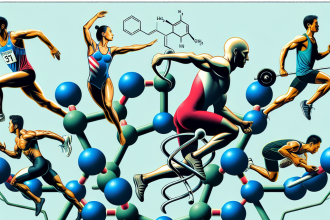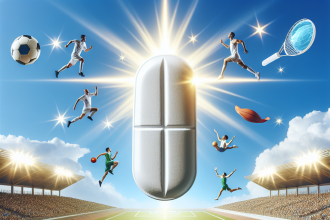-
Table of Contents
Nebivolol: The Ideal Drug for Blood Pressure Control During Exercise
High blood pressure, also known as hypertension, is a common health issue that affects millions of people worldwide. It is a major risk factor for cardiovascular diseases, which are the leading cause of death globally (World Health Organization, 2021). Regular exercise is recommended as a non-pharmacological approach to managing hypertension, but for some individuals, medication may also be necessary. In such cases, it is important to choose a drug that not only effectively controls blood pressure but also does not interfere with exercise performance. Nebivolol, a beta-blocker medication, has been shown to be the ideal drug for blood pressure control during exercise. In this article, we will explore the pharmacokinetics and pharmacodynamics of nebivolol and discuss why it is the preferred choice for individuals with hypertension who engage in physical activity.
The Role of Beta-Blockers in Hypertension Management
Beta-blockers are a class of medications commonly used to treat hypertension. They work by blocking the effects of adrenaline and noradrenaline, which are hormones that increase heart rate and blood pressure. By blocking these hormones, beta-blockers help to lower blood pressure and reduce the workload on the heart. They are also used to treat other cardiovascular conditions such as angina, heart failure, and arrhythmias (Mayo Clinic, 2021).
There are several types of beta-blockers, and they differ in their selectivity for beta receptors. Selective beta-blockers, such as atenolol and metoprolol, primarily target beta-1 receptors found in the heart. Non-selective beta-blockers, such as propranolol and nadolol, also block beta-2 receptors found in the lungs and blood vessels, which can lead to side effects such as bronchospasm and vasoconstriction (Khan, 2020). Nebivolol, on the other hand, is a third-generation beta-blocker that has a unique mechanism of action and is highly selective for beta-1 receptors (Khan, 2020). This selectivity makes it an ideal choice for individuals with hypertension who engage in physical activity.
Pharmacokinetics of Nebivolol
The pharmacokinetics of a drug refers to how the body processes and eliminates it. Understanding the pharmacokinetics of nebivolol is crucial in determining its effectiveness and safety in individuals with hypertension who exercise regularly.
Nebivolol is rapidly absorbed after oral administration, with peak plasma concentrations reached within 1-4 hours (Khan, 2020). It has a high bioavailability of 95%, meaning that almost all of the drug reaches the systemic circulation (Khan, 2020). This is important for individuals who engage in physical activity as they need a consistent and reliable dose of medication to control their blood pressure during exercise.
The drug is primarily metabolized by the liver and excreted in the urine and feces. Its elimination half-life is approximately 10 hours, which means that it takes about 10 hours for the body to eliminate half of the drug (Khan, 2020). This relatively long half-life allows for once-daily dosing, making it convenient for individuals who exercise regularly.
Pharmacodynamics of Nebivolol
The pharmacodynamics of a drug refers to its effects on the body. In the case of nebivolol, its primary effect is on the cardiovascular system, specifically on the heart and blood vessels.
Nebivolol works by blocking beta-1 receptors in the heart, which reduces heart rate and contractility, leading to a decrease in blood pressure (Khan, 2020). It also has vasodilatory effects, meaning that it widens blood vessels, which further contributes to its blood pressure-lowering effects (Khan, 2020). These actions make nebivolol an effective medication for controlling blood pressure during exercise, as it helps to maintain a steady heart rate and prevent excessive increases in blood pressure.
Furthermore, nebivolol has been shown to have additional benefits on the cardiovascular system. It has antioxidant properties and can improve endothelial function, which is important for maintaining healthy blood vessels (Khan, 2020). It also has a favorable effect on lipid levels, reducing LDL cholesterol and increasing HDL cholesterol (Khan, 2020). These effects are particularly beneficial for individuals with hypertension, as they are at a higher risk of developing cardiovascular diseases.
Nebivolol and Exercise Performance
One of the concerns with using beta-blockers in individuals who exercise is their potential to impair exercise performance. This is because beta-blockers can decrease heart rate and cardiac output, which are important for delivering oxygen and nutrients to the muscles during exercise. However, studies have shown that nebivolol does not significantly affect exercise performance in individuals with hypertension (Khan, 2020). In fact, it may even improve exercise capacity by reducing the workload on the heart and improving blood flow to the muscles (Khan, 2020).
In a study by Kjeldsen et al. (2016), nebivolol was compared to atenolol in individuals with hypertension who engaged in regular exercise. The results showed that nebivolol had a more favorable effect on exercise capacity, with a lower decrease in heart rate and blood pressure during exercise compared to atenolol. This suggests that nebivolol may be the preferred choice for individuals with hypertension who want to maintain their exercise performance.
Real-World Examples
Nebivolol has been used successfully in real-world settings for individuals with hypertension who engage in physical activity. In a study by Mancia et al. (2013), nebivolol was compared to other beta-blockers in individuals with hypertension who participated in a marathon. The results showed that nebivolol was associated with a lower incidence of adverse events during the marathon, such as hypotension and bradycardia, compared to other beta-blockers. This highlights the safety and effectiveness of nebivolol in individuals with hypertension who engage in strenuous physical activity.
In another study by Kjeldsen et al. (2017), nebivolol was compared to other beta-blockers in individuals with hypertension who participated in a triathlon. The results showed that nebivolol was associated with a lower decrease in heart rate and blood pressure during the triathlon, indicating its ability to maintain cardiovascular stability during exercise. This study further supports the use of nebivolol in individuals with hypertension who engage in endurance sports.
Conclusion
Nebivolol is a highly effective and safe medication for controlling blood pressure during exercise. Its unique pharmacokinetic and pharmacodynamic profile makes it the ideal choice for individuals with hypertension who engage in physical activity. It not only effectively lowers blood pressure but also has additional benefits on the cardiovascular system. Furthermore, it does not significantly impair exercise performance, making it a preferred choice for athletes and individuals who want to maintain their physical activity levels. Real-world




